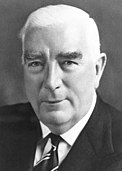Australian federal election, 1955
|
|
||||||||||||||||||||||||||||||||||
|---|---|---|---|---|---|---|---|---|---|---|---|---|---|---|---|---|---|---|---|---|---|---|---|---|---|---|---|---|---|---|---|---|---|---|
|
||||||||||||||||||||||||||||||||||
|
All 122 seats of the Australian House of Representatives 62 seats were needed for a majority in the House 30 (of the 60) seats of the Australian Senate |
||||||||||||||||||||||||||||||||||
|
||||||||||||||||||||||||||||||||||
|
||||||||||||||||||||||||||||||||||
Robert Menzies
Liberal/Country coalition
Robert Menzies
Liberal/Country coalition
Federal elections were held in Australia on 10 December 1955. All 122 seats in the House of Representatives, and 30 of the 60 seats in the Senate were up for election. The incumbent Liberal Party of Australia led by Prime Minister of Australia Robert Menzies with coalition partner the Country Party led by Arthur Fadden defeated the Australian Labor Party led by H. V. Evatt.
This would be the last federal election where any seat attracted only one candidate, who was elected unopposed.
In 1949, Robert Menzies founded the Liberal Party of Australia (descended from the United Australia Party), which was led by Menzies for 16 years through successive elections with the traditional coalition in place with the Country Party. Labor stayed out of government for 23 years after the defeat of the Chifley government in 1949, largely due to the Australian Labor Party split of 1955 and the subsequent splinter group Democratic Labor Party. Labor nevertheless won the two-party-preferred vote (the 1954, 1961 and 1969 elections), but not enough seats to form government. The election saw the peak of the Communist Party Senate vote, with 161,869 at 3.64 percent.
...
Wikipedia


